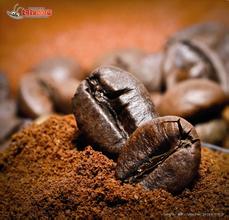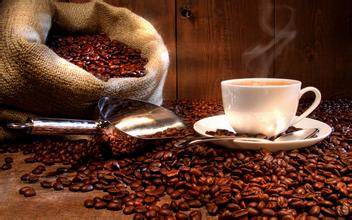Temperature curve of Starbucks concentrated roasted coffee beans
Temperature curve of Starbucks concentrated roasted coffee beans
The TG-DTG curve of combustion under air atmosphere and 10 ℃ min-1 heating rate is similar to the biomass combustion model proposed by Min Fanfei et al. (2005). The TG curve is the curve of the relationship between weight and temperature, while the DTG curve is obtained from the derivative of TG curve to time, which represents the rate of change of weight with time. According to the TG curve of figure 1, the combustion of coffee grounds can be divided into three stages: the Ⅰ stage (500 ℃) is the stable stage of burnout, with only residual ash burning, with an initial weight of about 7%, corresponding to the ash content (7.05%).
In the DTG curve, there is a weight loss peak representing water evaporation in the Ⅰ stage, and there are three weight loss peaks in the Ⅱ stage, which represent the precipitation combustion of the main volatile (289 ℃), the precipitation combustion of the secondary volatile (402 ℃) and the combustion of fixed carbon (484℃), among which the combustion of the main volatilization analysis is the most obvious, and the weight loss peak is stable in the Ⅲ stage.
In the process of recording the baking curve, carefully blindly test each batch of baked beans, record them, and accurately grasp the key elements, you can easily get the taste of coffee beans! Remember that each batch of coffee beans has a different baking curve and roasting methods.
The environmental factors of raw coffee beans in the producing areas will also affect the quality of raw coffee beans. The rainfall in the producing area this year and last year, or the drying process of coffee before export, is also one of the key points.
High-altitude and ripe coffee beans usually last longer and have a longer life. Because of the high density of raw coffee beans, if the dry environment is good, the taste of the coffee itself will not change much.
Out-of-season coffee beans are not good, and old coffee is sometimes added to some coffee varieties. to put it simply, African coffee beans taste clean, bright and slightly thin when fresh. After being placed for a period of time, the volatile aroma of the coffee is thicker and sweeter.
Bake, cup test, bake, cup test! After continuous adjustment and taste of different coffee curve roasted coffee, so that the taste of coffee to achieve better!
Use your senses: eyes, nose, ears, and mouth to learn more about the characteristics of coffee. Master the perfect baking curve
When paying attention to the process of coffee change, the baker can use the above factors to judge and design the baking curve. To put it simply: when the raw beans go directly into the roaster, how long will it take to warm up before the curve on the thermometer begins to climb slowly up. When the coffee beans are dehydrated and turn orange, how long does it take to produce the first explosion, reach the ideal color card, or reach the baking level of the second explosion? The roaster needs to take how many baking samples to judge the time of the coffee.
Both new and old beans have their own unique baking curve, so it is necessary to accurately judge the bean and the time of emergence, and master the best flavor.

Important Notice :
前街咖啡 FrontStreet Coffee has moved to new addredd:
FrontStreet Coffee Address: 315,Donghua East Road,GuangZhou
Tel:020 38364473
- Prev

Introduction to the Grinding scale of Coffee Flavor description in Latin America
Latin American Coffee Flavor description treatment Variety characteristics Regional Grinding scale introduction Coffee of choice is one of the top 10 best-selling coffee and partner favorite coffee in the United States. In fact, it is coffee that lets the world know the taste of Starbucks, because coffee is sold in catering industries such as hotels, restaurants and campuses. An excerpt from Starbucks' preferred coffee this great coffee can lead you to explore
- Next

Introduction to the origin of taste description of siphon pot coffee bean hand-made flavor in Costa Rica
Costa Rican siphon pot coffee bean hand-made flavor description of taste origin introduction the longer the extraction time, the thicker the coffee flavor, but in order to ensure the integrity of the coffee flavor, the extraction time is not easy to be too long, it is recommended to keep it at about 1 minute. Stirring skills: pour coffee powder into water and stir 15 times evenly, not too fast or too slow. The best condition after stirring is thicker at the top.
Related
- Detailed explanation of Jadeite planting Land in Panamanian Jadeite Manor introduction to the grading system of Jadeite competitive bidding, Red bid, Green bid and Rose Summer
- Story of Coffee planting in Brenka region of Costa Rica Stonehenge Manor anaerobic heavy honey treatment of flavor mouth
- What's on the barrel of Blue Mountain Coffee beans?
- Can American coffee also pull flowers? How to use hot American style to pull out a good-looking pattern?
- Can you make a cold extract with coffee beans? What is the right proportion for cold-extracted coffee formula?
- Indonesian PWN Gold Mandrine Coffee Origin Features Flavor How to Chong? Mandolin coffee is American.
- A brief introduction to the flavor characteristics of Brazilian yellow bourbon coffee beans
- What is the effect of different water quality on the flavor of cold-extracted coffee? What kind of water is best for brewing coffee?
- Why do you think of Rose Summer whenever you mention Panamanian coffee?
- Introduction to the characteristics of authentic blue mountain coffee bean producing areas? What is the CIB Coffee Authority in Jamaica?

